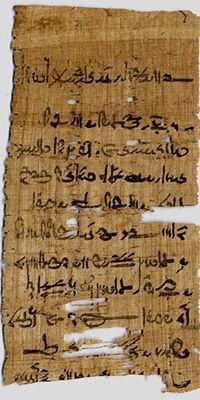Ancient Egyptian Ink From Papyri Manuscripts Had Copper, X-ray Microscopy Reveals

A team of researchers from the University of Copenhagen conducted a study analyses of 2,000-year-old papyri fragments with X-ray microscopy which show that black ink used by Egyptian scribes also contained copper — an element previously not identified in ancient ink.
Scientists from across the world were surprised to find that ancient ink contained copper. The ink was always assumed to be carbon-based. The ink, which was used for writing was considered to be carbon-based at least until the fourth and fifth centuries AD.
The study published in Scientific Reports was conducted by a team of cross-disciplinary researchers. They analyzed several papyri fragments to study the composition of ancient ink. The analyzed papyri fragments were written over a period of 300 years and from different geographical regions. This did not change the results of the study.
"The composition of the copper-containing carbon inks showed no significant differences that could be related to time periods or geographical locations, which suggests that the ancient Egyptians used the same technology for ink production throughout Egypt from roughly 200 BC to 100 AD," says Egyptologist and first author of the study Thomas Christiansen from the University of Copenhagen in a news release on their website.
Advanced synchrotron radiation based X-ray microscopy equipment at the European Synchrotron Radiation Facility in Grenoble was utilized to study the 300-odd fragments that they had amassed. The study was conducted as a part of the cross-disciplinary CoNext project and the particles found in the inks indicate that they were by-products of the extraction of copper from sulphurous ores.
According to the press release, they studied papyri fragments which were all a part of a larger manuscript set belonging to the Papyrus Carlsberg Collection at the University of Copenhagen. The papers originated from two sources, the private papers of an Egyptian soldier named Horus, who was a soldier at a military camp in Pathyris, and from the Tebtunis temple library, which is the only surviving large-scale institutional library from ancient Egypt.
"None of the four inks studied here was completely identical, and there can even be variations within a single papyrus fragment, suggesting that the composition of ink produced at the same location could vary a great deal. This makes it impossible to produce maps of ink signatures that otherwise could have been used to date and place papyri fragments of uncertain provenance," said Thomas Christiansen.
"However, as many papyri have been handed down to us as fragments, the observation that ink used on individual manuscripts can differ from other manuscripts from the same source is good news insofar as it might facilitate the identification of fragments belonging to specific manuscripts or sections thereof," he added.
The team hopes that their results will help conserving the manuscripts. Knowing the composition of these artifacts could help scientists figure out a better way to preserve these links to our past. They are important flag posts of human development and ancient messages are evidence of growth of our species through time. The team also hopes that further study of historical manuscripts helps people understand human progress better.
© Copyright IBTimes 2025. All rights reserved.





















